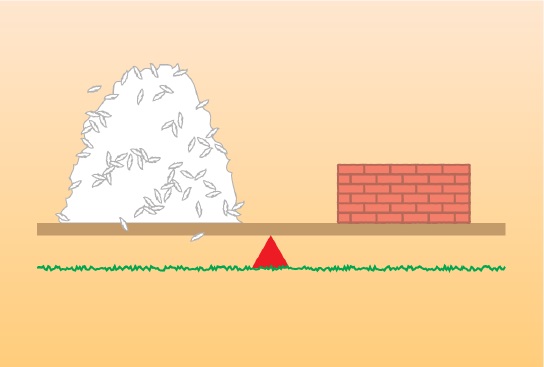Tons and tons of tons
Evan Zabawski | TLT From the Editor May 2015
Weighty matters of mass.

What weighs more, a tonne of feathers or a long ton of bricks?
AN OLD RIDDLE ASKS WHAT WEIGHS MORE, a ton of feathers or a ton of bricks? Perhaps a slightly harder question would be: what weighs more, a tonne of feathers or a ton of bricks? An even harder question would be, what weighs more, a tonne of feathers or a long ton of bricks?
The riddles can only be answered by clarifying the various types of tons. Confusion begins because a ton can be a unit of mass as well as a unit of volume. The ton is derived from the tun, which describes the volume of a wine barrel of the largest size.
A tun is a barrel that is six times larger than the common barrel, originally 256 gallons but later reduced to 252 gallons in order to be evenly divisible by small integers. It is also approximately the equivalent volume of a cylinder 42 inches in both diameter and height. The mass of a tun of wine and its barrel is approximately equal to a long ton.
A long ton, or imperial ton, is defined as having a mass of 2,240 pounds, equivalent to 35 cubic feet of saltwater having a density of 64 pounds per cubic foot. It is also equivalent to 20 hundredweight, with each hundredweight equal to eight stone, and a stone being 14 pounds.
This unit no longer exists in countries with metricated measuring systems. Those countries employ the metric ton, or more commonly tonne (as accepted by the International System of Units (SI) but is officially a megagram), a mass equivalent to 1,000 kilograms (2,204.6 lbs). Though tonne is spelled differently, it is typically pronounced the same as ton, without emphasis on the
e. It is frequently misspelled the same as ton, and this acceptance likely stems from the small (~1.6%) difference in masses.
In contrast to a long ton, the short ton, used primarily in the United States, is defined as 2,000 pounds, which is also equivalent to 20 hundredweight, but in the U.S. system a hundredweight is equal to 100 pounds.
When using mass as a proxy to energy, as in a megaton, the inference is the equivalent energy produced by one tonne of TNT, which is equal to 4.184 gigajoules (GJ) of energy. The tonne of oil equivalent (toe) is the amount of energy released by burning a tonne of crude oil, which is defined by the International Energy Agency as 41.868 GJ.
Quantifying the cargo-carrying capacity of a ship, tonnage or deadweight tonnage (DWT), originally referred to the weight of a ship’s cargo, which was based on the rounded value of 100 cubic feet of internal space per ton. Historically reported in tons, it has reverted to a volumetric representation of the volume or cargo volume of a ship and is now reported internationally in tonnes. Displacement or displacement tonnage, on the other hand, does refer to the actual weight of the ship, represented by the tonnes of water displaced.
A less common example would be the water ton, equal to 224 imperial gallons, the volume of water in one long ton, weighed in a 30 inHg atmosphere at 62 F. Other less formal variants exist, only increasing the popularity of the term and blurring the distinction between each one.
With so many variants, it can be hard to make sense of the specifications of a supertanker carrying a shipment of oil. The Seawise Giant, for example, had a displacement of 81,879 long tons empty but 646,642 long tons under full load (or 657,019 tonnes or 724,239 short tons). Her capacity was 4,240,865 barrels, and at an average of 302.82 pounds per barrel of crude that works out to 642,109.37 short tons of crude. The energy capacity would be 641,174.05 tonnes of oil equivalent, yet only weigh 582,512 tonnes.
So she can be full with less weight than is possible (due to density) and contain a discrepant amount of energy that does not align with a mass measurement using complementary units. It was tricky figuring all this out, but I had a ton of fun doing it.
 Evan Zabawski, CLS, is the senior reliability specialist for Fluid Life in Edmonton, Alberta, Canada. You can reach him at evan.zabawski@fluidlife.com
Evan Zabawski, CLS, is the senior reliability specialist for Fluid Life in Edmonton, Alberta, Canada. You can reach him at evan.zabawski@fluidlife.com.